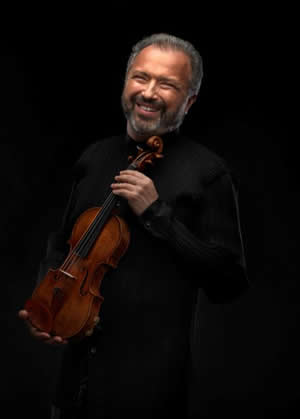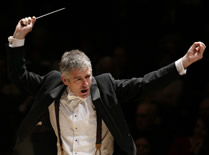The 2014-15 Masterworks series of the Greensboro Symphony Orchestra began in a vocal fashion in Dana Auditorium on the Guilford College campus Thursday night. The title of the concert, “Family Comes First,” is completely apropos as GSO Artistic Director, Dmitry Sitkovetsky, who led the orchestra, was joined by his daughter, Julia, who served as soprano soloist throughout the evening. But, as they say, “Wait…, there’s more.” On Sunday, Maestro S, Julia and her grandmother, Dmitri’s mother, the distinguished pianist Bella Davidovich, will join in a three generation chamber music concert.
Thursday evening opened with one of the most famous pieces in the literature, Overture to The Barber of Seville, by Gioachino Rossini (1792-1868). In discussing the piece with my music theory class at Guilford, all of the students were familiar with the work, not because they frequent the concert hall, but because Bugs Bunny has immortalized famous passages from the opera in cartoon.
Actually the overture is recycled from two earlier operas (hence there are no tunes from the ensuing opera present in the instrumental opening). The GSO’s performance was taut – clean playing from beginning to end with unerring solos from horn, flute, clarinet, and bassoon. The music bubbles with good energy, and the overture concludes with a rush of excitement, a perfect way to begin a night of music.
Ms. Sitkovetsky joined the orchestra to sing two arias: “Caro nome” from Rigoletto (1851) by Giuseppe Verdi (1813-1901) and “Regnava, nel silenzio” from Lucia di Lammermoor (1835) by Gaetano Donizetti (1797-1848). The soprano captivated with the range needed to negotiate the demands of both arias. Her lovely vibrato and impeccable intonation reveal solid technique, and her ability to pare notes down to a delicate pianissimo was stunning. While her voice is not particularly large (sometimes becoming covered in the Donizetti), her artistry and ability to convey the emotions of each aria was entirely engaging.
A standing ovation brought Ms. Sitkovetsky back to the stage of an encore: “O mio babbino caro” from Gianni Schicchi. In this popular aria, a daughter sings to her father, pleading for his blessing on her love for a boy who is from a rival family. If he does not grant this, she threatens to throw herself into the Arno river. The theater between daughter and father was clever and fun.
The second half of the concert was given over to the hour-long Symphony No. 4 by Gustav Mahler (1860-1911). The work, written between 1899 and 1900, is Mahler’s least dark work. Indeed the focus of the work lies in the fourth movement, which is a child’s view of heaven. For this, Mahler used one of his previously written songs from Des Knaben Wunderhorn (The Youth’s Magic Horn), which he penned in 1892.
The symphony is in four movements and is distinguished by the chamber-like quality: solo lines from practically every section of the orchestra (especially notable was the horn) are characteristic. Unusual elements also include the use of sleigh bells and a violin tuned “like a fiddle” to represent death in the second movement.
Mahler once said “A symphony must be like the world. It must embrace everything,” and his Fourth is no exception. Often the sequence of events that take place in the course of a movement happen in a seemingly non sequitur fashion. For example, the first movement begins with sleigh bells and four flutes, leading directly into a lilting, good humor violin melody, but a cataclysmic climax eventually arrives and not even the sleigh bells can avoid the meltdown.
The second movement is a type of scherzo and concertmaster John Fadial alternated between his regular violin and the “fiddle” violin to evoke the rustic sound demanded by the score. The third movement (clocking in at more than 20 minutes) is one of those slowly evolving, gorgeously developing movements for which Mahler is justly famous. Yet even here a violent outburst occurs with the timpani intoning the opening pizzicato passage.
The last movement brought Julia Sitkovetsky back to the stage to join the orchestra in “Das himmlische Leben” (“The Heavenly Life”). Between the verses of the song, the orchestra offers lively orchestral interludes. This is a lovely movement and Ms. Sitkovetsky once again proved her interpretive skills.
The work is a test of endurance for both orchestra and audience and both remained attentive throughout. Maestro Sitkovetsky, for his part, kept the orchestra alive with both energy and subtle tenderness. Indeed, at the soft conclusion of the work, the audience sat mesmerized for several seconds before thundering applause showed its appreciation for the wonderful music making by all.
A final bone to pick. There were no translations offered either for the arias or the symphony. Perhaps the audience could be expected to understand the meaning of the aria from the soloist’s theatrical gesturing, but certainly not for the symphony.
This program will be repeated September 27. For details, see the sidebar. And the Maestro turns 60 the next day, so naturally there’s a big extravaganza, as noted above. It’s sold out, with a waiting list, but for details, click here.












